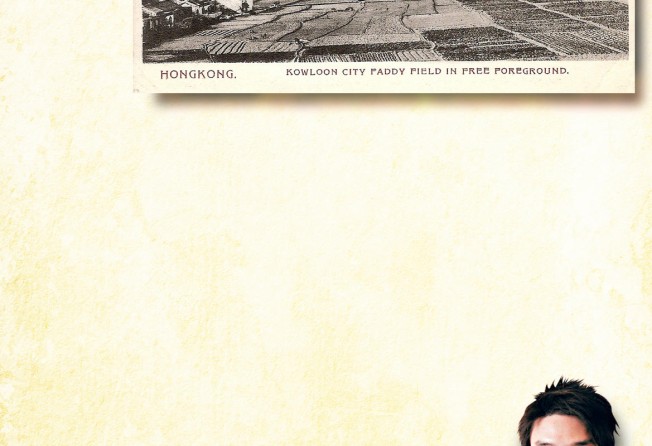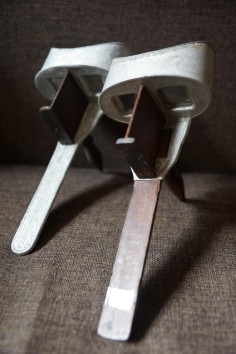
Hong Kong Collectors Society brings city's past into focus for 20th anniversary
The Hong Kong Collectors Society has assembled a treasure trove of historic keepsakes to celebrate its 20th anniversary, writes Charley Lanyon

Christopher Newall owes his love affair with postcards to his father-in-law. An Italian commander who served in Ethiopia, the old man kept mementoes from that period in a big wardrobe at home.
One day, Newall says, "I opened it up and found it stacked with pictures of dusky maidens from Eritrea, chiefs and armies, and all this sort of stuff and I just fell in love with postcards."

Newall's posting in 1985 changed the focus of his collecting: "When I knew I was coming to Hong Kong, I went around England and got, for next to nothing, around 400 Hong Kong postcards. I arrived here ready to proselytise the virtues of ancient postcards."
He soon came across others who shared his enthusiasm for collecting and for the history of Hong Kong; in particular, three men he kept running into while scouring antique shops. Increasingly drawn together, the four decided in 1994 to start a society, where they could pool expertise or swap collectibles.
His description of their formation almost recalls the assembly of crack teams in a classic heist movie: "There's me, postcard maniac. There's Dr William Tong Cheuk-man, a medical consultant for Queen Elizabeth Hospital, he had two passions: the Swedish explorer Sven Hedin and the Japanese Occupation ... Alan Cheung was the transport guy … he was after anything having to do with trams. And then there was Cheng Po-hung, a stamp dealer. He was the philatelic input."
They began with just 10 members and, unusually for that time, comprised a fair mix of Chinese and Europeans. Today, its membership is still predominantly male but made up mostly of Hong Kong Chinese. Most European members were civil servants and left after the handover in 1997. Cheung, the current vice-president, jokes: "Government employees did a lot of collecting because they had a lot of money and free time."
There are about 100 members, 40 of whom are active. Well-known members include Dr Joseph Ting Sun-pao, former chief curator of the Museum of History, and Hung, who regularly appears on television as an expert on old Hong Kong.
Collecting is a costly pursuit, but Tong says the society promotes the hobby for ordinary folk, so fees are kept low - a lifetime membership is just HK$500.

The society's first publication took on a timely subject: the Kowloon Walled City. A historical settlement that grew into an unruly enclave rife with crime, it was facing demolition in 1994.
"Every member contributed something … As the place was being pulled down we were producing this publication and it sold like hotcakes," Newall says.
Their next endeavour proved to be an even bigger success: "When Kai Tak [airport] closed, William Chou, another member and a really good photographer, took photos of the last flight out and we published postcards of it and sold them."
These two early projects speak to what has become one of the society's key roles: preserving and publicising records of old Hong Kong as new developments bury signs of the past.
While some historical records have been lost to ignorance or negligence, others were destroyed in times of conflict - the second world war being a prime example.
"The Japanese burned everything that was paper," Newall says. "Whole libraries were burned just to heat rooms … The entire paper record in Hong Kong was destroyed by 1945 so the only place to find it was outside."
Collectors are usually keen to share their finds and it isn't long into a conversation before briefcases containing faded postcards, or century-old sepia-tinted portraits are brought out.
Among Tong's treasures are shipping ledgers that log the opium trade and receipts of protection money paid to Japanese thugs during the occupation. One item held special significance: a wartime ration card bearing the signatures of his mother, father and sister.
Twenty years ago, Tong was one of the few Hong Kong people interested in gathering relics from the dark period that was the Japanese occupation. Newall recalls being surprised by his friend's passion: "Nobody talked about it in the '80s; it was considered a shame."
The society has been instrumental in tracking down historical records of pre-war Hong Kong and bringing them back to the city so all can learn from the past.
While preserving the past is important, Newall says the society's greatest achievement lies in the present.
"I think one of the interesting things that happened [in the past 20 years] which this society helped to do is create Hong Kong identity … When I first arrived, Hong Kong was a bit sleepy hollow … Come Chinese New Year, the population headed off to their ancestral homes - people living here were acting like they were refugees … They didn't have a sense of being Hong Kong belongers."
The society helped change that, Newall says. "I really think that looking back at the history of a place and informing people about it gives people a sense of who they are and where they come from."
But lest anyone think that collecting historical artefacts is the realm of old men, they need only look to Lawrence Chow Ho-ching. The 25-year-old holds a degree in creative media, but his particular obsession is old images of Hong Kong that show off its unique architecture.
Chow seems almost giddy when discussing his prized possession, a rare stereo-card viewer from the 1850s. The device creates a kind of 3-D effect when a type of card with mirror images is viewed through its lenses.
"You can see the old ladies sitting in the sedan chairs, and next to her is a dog. So interesting," he says. "It feels like I'm inside the pictures."
Now lecturing part-time at a community college, Chow joined the society two years ago after meeting Cheung at an exhibition on trams, and membership has conferred a measure of validation for his hobby.
"Some of my friends think I'm so weird. 'Why do you like that old stuff? You're so young.' But I don't think so ... Now I have lots of friends who share the same mission."
Highlights from personal collections, including Chow's stereo-cards, will feature at the society's 20th anniversary exhibition opening tonight.
Hong Kong Collectors Society 20th Anniversary Exhibition, Central Library Exhibition Gallery, 66 Causeway Bay Rd. Ends Mar 27